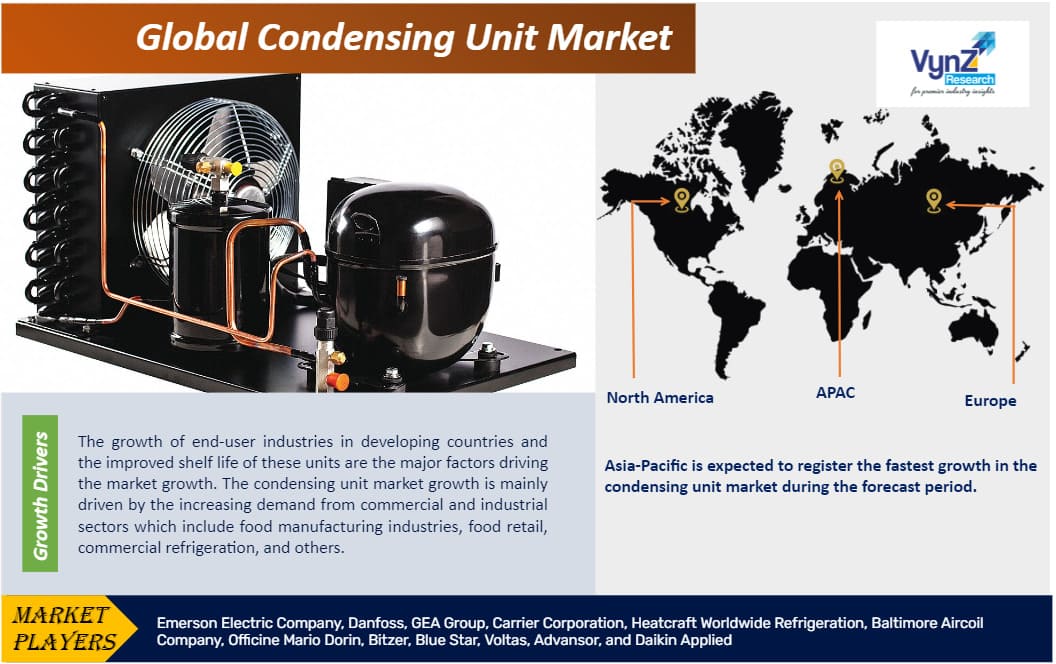Industry Overview
The global condensing unit market was estimated at USD 24.2 billion in 2023 and is expected to rise to USD 38.6 billion by 2030, with a compound annual growth rate of 6.7 %.

The condensing unit is another name for the outdoor HVAC unit. These units can either be an air conditioning unit or a heat pump. These are temperature-control devices in air conditioners, refrigerators, heat pumps, and chillers. They move energy in the form of heat by compressing gas and then pump it through a system of coils, further, using the coil to heat and cool spaces. The typical component of this unit includes a compressor, fan, and condensing coil. The condensing unit market is projected to register significant growth during the forecast period, owing to its extensive use in cold rooms, milk cooling tanks, fermentation rooms, supermarkets, hospitals, and others.
Condensing Unit Market Segmentation
Insight by Type
Based on type, the condensing unit market is segmented into air-cooled, water-cooled, and evaporative condensing unit. Of all these, the air-cooled condensing unit category is expected to hold the largest share in the market during the forecast period. This is attributed to the various factors in terms of advantages it offers to the users, such as, low maintenance cost, low installation cost, wide commercial applications, rising water scarcity, and others. All these factors are driving the demand of these units in the market, resulting in market growth.
Insight by Application
On the basis of application, the condensing unit market is categorized into commercial, industrial, and transportation. The industrial segment is leading the market and is also expected to witness the fastest growth in the coming years. This can be attributed to the increasing demand for advanced refrigeration from different industries in various application areas including power plants, retail stores, dairy cabinets, hospitals, and others.
Insight by Function
Based on function, the condensing unit market is categorized into air-conditioning, refrigeration, and others (heat pumps). Of all these, the air-conditioning category is dominating the market, registering the fastest growth in the market. Owing to the multi-utility of these units in different end-user industries such as industrial facilities, office buildings, schools, and others, the market is expected to witness significant growth during the forecast period.
Global Condensing Unit Market Report Coverage
|
Report Metric
|
Details
|
|
Historical Period
|
2018 - 2023
|
|
Base Year Considered
|
2024
|
|
Forecast Period
|
2025 - 2030
|
|
Market Size in 2024
|
U.S.D. 24.2 Billion
|
|
Revenue Forecast in 2030
|
U.S.D. 38.6 Billion
|
|
Growth Rate
|
6.7%
|
|
Segments Covered in the Report
|
By Type, By Application, and By Function
|
|
Report Scope
|
Market Trends, Drivers, and Restraints; Revenue Estimation and Forecast; Segmentation Analysis; Impact of COVID-19; Companies’ Strategic Developments; Market Share Analysis of Key Players; Company Profiling
|
|
Regions Covered in the Report
|
North America, Europe, Asia-Pacific, Middle East, and Rest of the World
|
Industry Dynamics
Condensing Unit Market Growth Drivers
The growth of end-user industries in developing countries and the improved shelf life of these units are the major factors driving the market growth. The condensing unit market growth is mainly driven by the increasing demand from commercial and industrial sectors which include food manufacturing industries, food retail, commercial refrigeration, and others. Along with that, the increasing commercial complexes, banqueting suites, office space, and others are further expected to drive the growth of the market in the coming years.
Condensing Unit Market Challenges
The major challenge identified in the condensing unit market is the strict regulations regarding the usage of refrigerants in condensing units. In recent years, the U.S. Department of Energy (DOE) issued various regulations affecting HVACR equipment manufacturers and they have to adapt to these regulatory changes that affect both efficiency requirements and refrigerants. For instance, the F- gas (HFCs, PFCs, and SF6) regulation was revised in 2015 by the European Union (EU) Commission to restrict rising emissions that might restrain the condensing unit market.
Condensing Unit Market Industry Ecosystem
The condensing unit market is highly fragmented and competitive. The companies are struggling because of the lack of service differentiation, customer loyalty, and market growth. The customers in the market are demanding more transparency and efficient delivery.
Recent Developments By the Key Players
Emerson introduced the Anderson Greenwood Type 84 pressure relief valve, designed to optimize safety and performance in critical gas applications, including hydrogen storage, transport, and refueling stations. These developments reflect Emerson's strategic focus on expanding its industrial automation capabilities, enhancing financial performance, and introducing innovative products to the market.
Danfoss announced plans to progressively ramp up its local manufacturing capabilities in India over the next five years. This initiative aligns with the Indian government's "Make in India" campaign and aims to strengthen Danfoss's presence in the Indian market by enhancing its manufacturing footprint.
Condensing Unit Market Geographic Overview
Globally, Asia-Pacific is expected to register the fastest growth in the condensing unit market during the forecast period. The factors contributing to the region’s growth are the growth in chemical and power industries. Also, the increasing demand for food processing and storage facilities is also contributing to the market growth in the region. In Asia-Pacific, China is the largest consumer of these units, owing to the increasing population, which is resulting in increasing demand for these units in order to meet the demand.
Condensing Unit Market Competitive Insight
- Emerson Electric Company
- Danfoss
- GEA Group
- Carrier Corporation
- Heatcraft Worldwide Refrigeration
- Baltimore Aircoil Company
- Officine Mario Dorin
- Bitzer
- Blue Star
- Voltas
- Advansor
- Daikin Applied
The Condensing Unit Market report offers a comprehensive market segmentation analysis along with an estimation for the forecast period 2025–2030.
Segments Covered in the Report
- Type
- Air-Cooled
- Water-Cooled
- Evaporative Condensing Unit
- Application
- Commercial
- Industrial
- Transportation
- Function
- Air-Conditioning
- Refrigeration
- Others (Heat Pumps)
Region Covered in the Report
- North America
- Europe
- Germany
- U.K.
- France
- Italy
- Spain
- Russia
- Rest of Europe
- Asia-Pacific (APAC)
- China
- Japan
- India
- South Korea
- Rest of Asia-Pacific
- Rest of the World
- Middle East and Africa (MEA)
- South America
.png)
Source: VynZ Research
.png)
Source: VynZ Research




.png)
.png)